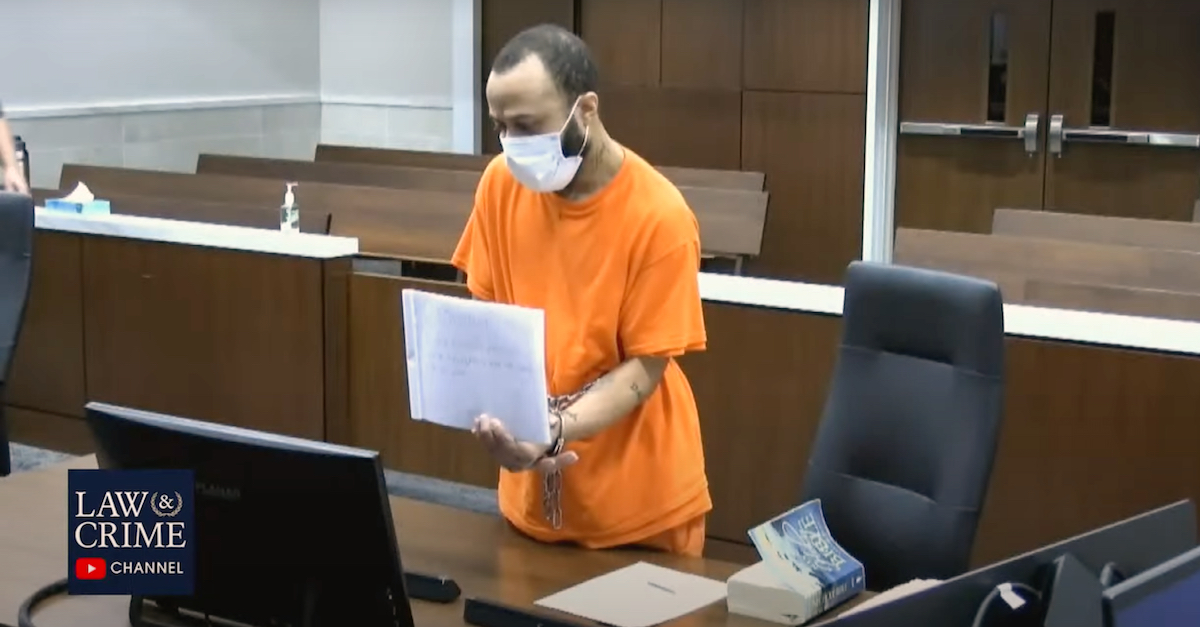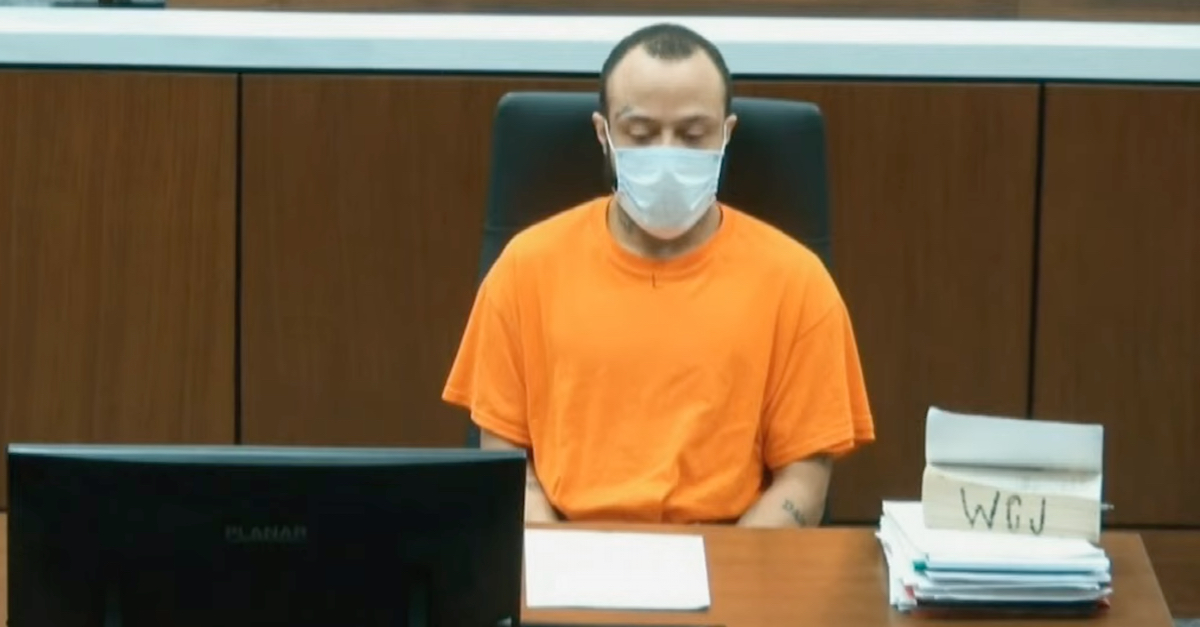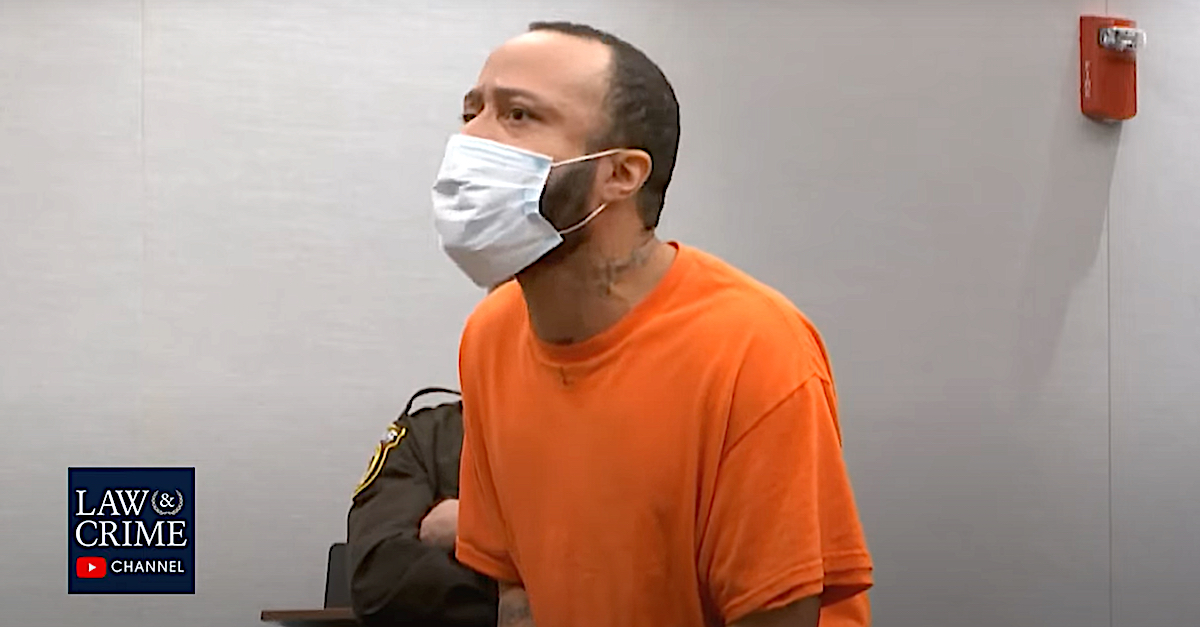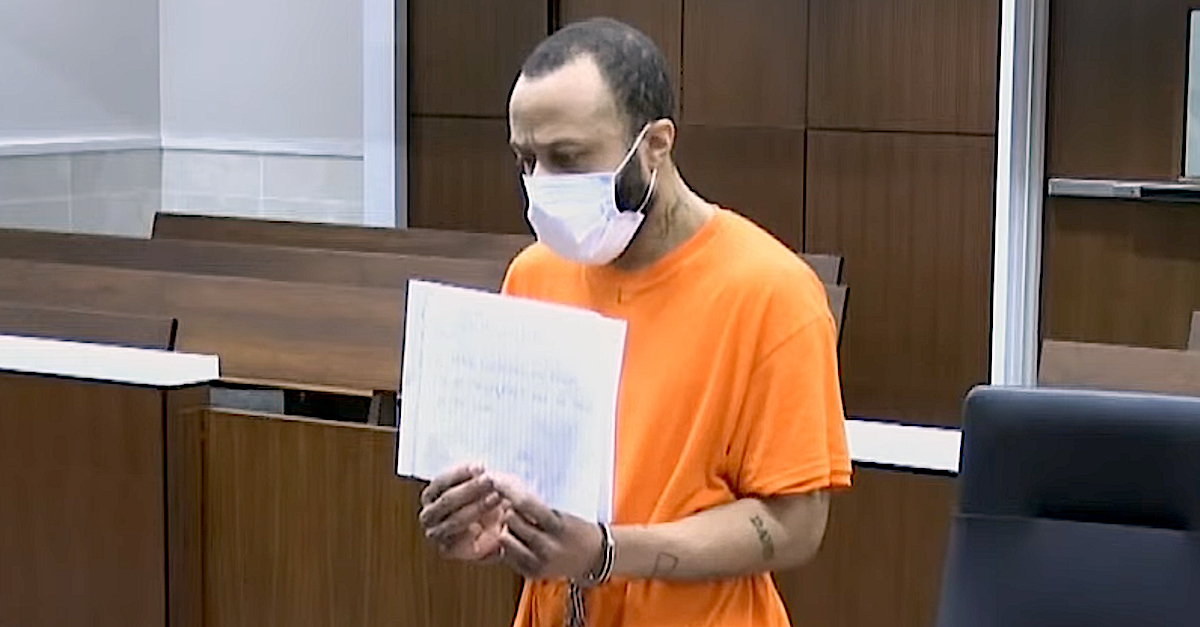
Darrell Brooks was led off to prison from a remote courtroom after being sentenced. (Image via the Law&Crime YouTube channel.)
Waukesha, Wisconsin holiday parade attacker Darrell Brooks will almost surely die in prison after receiving multiple life sentences and additional terms of incarceration on a sum total of 76 separate criminal charges.
Judge Jennifer Dorow issued six consecutive — or back to back — life sentences with no possibility of extended supervision for each of the six victims of the Nov. 21, 2021 attack that left scores of others injured.
Dorow then issued 17.5 year sentences for attacks on a long list of other victims who survived. She issued 25-year sentences (15 years behind bars plus ten years of extended supervision) on counts 68 through 73. Those sentences each were slated to run concurrent to the six life sentences.
Dorow then sentenced Brooks to serve six years (three years behind bars plus three years of extended supervision) on counts 74 and 75. They will run consecutive to all other counts but concurrent to each other, the judge said.
Finally, Dorow sentenced Brooks to nine months behind bars — again consecutive to any other sentence — for battery. That charge — the 76th and final count — was connected to an attack on his onetime girlfriend Erika Patterson. The judge agreed with prosecutors that Brooks became enraged during an altercation involving Patterson and went on to mow down seven blocks of parade-goers on the aforementioned date.
“You deserve it,” the judge said after reading the sentences and reciting the names of all the victims.
She also ordered Brooks to have no contact with any victims, no contact with Erika Patterson specifically, restitution of more than $47,000 to an insurance company on behalf of the Waukesha School District, restitution of more than $124,000 to a crime victim compensation program, DNA surcharges on all counts, a domestic abuse surcharge, and other court costs.
Brooks heard the sentence from a remote courtroom due to multiple outbursts earlier in the proceeding.

Darrell Brooks stood and watched his own sentence being read from another courtroom. (Image via the Law&Crime YouTube channel.)
Before issuing the sentence, Dorow spoke for more than an hour and asked Brooks rhetorically: “Why didn’t you stop?” She was referring to his decision to continue down the parade route injuring and killing people in his wake.
Dorow noted that Brooks drove three blocks “before striking anyone” and then engaged in five blocks of “chaos and carnage.” She said the evidence showed that Brooks was driving between 33 and 34.5 miles per hour at one point during the attack and an “average of 32 miles per hour” at another point.
“Even though it took just a couple of minutes, there were so many opportunities for Mr. Brooks to simply stop, turn around, turn down other streets,” the judge said.
The judge described the aftermath left behind on four of the blocks as resembling a “war zone.”
At 4:37 p.m., a police officer first encountered Brooks, and the judge said Brooks had “ample time” to turn down several other streets before engaging in the attack on the parade route. Rather, Brooks drove straight into the crowds by taking a right-hand turn.
A police officer pounded on the hood of Brooks’ car, but Brooks didn’t stop, the judge noted. He ignored barricades, parade floats, and continued through the crowds.
“There’s no reasonable explanation other than: he was angry, he was full of rage, and he didn’t care who he came into contact with, what he came in contact with, whether he drove past, through, at — he drove,” the judge said, citing evidence at trial.

Darrell Brooks waves a piece of paper from a remote courtroom after being banished from Judge Dorow’s courtroom. (Image via the Law&Crime YouTube channel.)
“It’s hard not to think about what I watched and not have this reaction,” the judge said as she discussed video evidence of Brooks driving through the parade route and became emotional in the process. “Those are images that frankly kept me up at night that I saw over and over and over.”
Dorow said a band director who testified about students and their formations that night was a “hero to me” for discussing her experiences on the record in court.
“This was driving over people,” the judge said, underscoring other testimony.
The judge also pushed back at Brooks’ slams against the district attorney earlier in the proceeding, saying the DA was completely within her legal rights to present the case and her sentencing arguments as she indeed did.
At one point, Brooks exploded in what the judge called a “tirade.” The outburst was typical of his behavior throughout the trial. After several admonishments to stand down, Brooks continued; the judge removed him to a separate courtroom to watch the proceeding remotely.

Darrell Brooks tries to get Judge Jennifer Dorow’s attention from a remote courtroom after causing an outburst in front of her. (Image via the Law&Crime YouTube channel.)
Brooks, from that remote courtroom, at times waved a piece of paper back and forth in front of a camera. At several points, a bailiff appeared to present Dorow with a note from Brooks; the judge rejected it as insufficient to ensure his participation in the proceeding without being a disruption.
Dorow noted that Brooks lied about being “thrown to the ground” when he was arrested. No force was used, the judge said, citing video of the arrest; rather, Brooks “cooperated” with the officers. Dorow said Brooks also lied about why he was in Waukesha and who he was with.
The judge spent considerable time lauding the victims’ testimony and healing processes. She called out many by name in a nearly two-hour speech before reading the sentence but regretted that she couldn’t comment on each of them personally due to time constraints.
She did, however, expressly note that a child, Tucker Sparks, then age 12, told the court that he blamed himself for his 8-year-old brother Jackson Sparks’ death.
“It’s not your fault, Tucker,” the judge said, again becoming emotional and holding back tears. “It’s Mr. Brooks’ fault.”

An emotional Judge Jennifer Dorow delivers remarks before sentencing Darrel Brooks. (Image via the Law&Crime YouTube channel.)
Brooks, from the remote courtroom, incessantly attempted to draw the judge’s attention; when Dorow allowed Brooks to return, he continued to argue with her. The judge again removed him from the courtroom and accused him of attempting to delay his inevitable sentencing.
Mental Health Concerns
Judge Dorow kicked off her portion of the sentencing proceeding by spending considerable time rubbishing Brooks’ mental health excuses for what occurred.
“Mental health issues did not cause him to do what he did . . . and frankly did not play any role,” Dorow concluded.
Brooks initially entered a plea of not guilty by reason of mental disease or defect, but four “well-known doctors” studied Brooks, the judge said. Four commensurate reports were 24, 8, 26, and 12 pages long, respectively, the judge continued, and they incorporated comments from previous mental health treatments.
One of those report said Brooks was “indifferent,” “rationalizing,” and had a “history of disregarding the rights of others,” the judge said from the bench.
The experts suggested that Brooks’ mental disease or defect plea was not correct and could not be used at trial, Dorow repeated.

Darrell Brooks. (Image via the Law&Crime YouTube channel.)
The legal defense of insanity is different — and involves a more narrow question — than the broader medical inquiry of mental illness and mental health. While a defendant may have received a medical mental health diagnosis and/or treatment, the legal question is separate and, in general, forces the court to look at whether a defendant’s mental state shows evidence of criminal culpability. Four states do not recognize traditional insanity defenses. The remaining states generally employ one of four legal tests to determine whether a defendant is legally insane; however, of those four tests, two are by far the most common. In Wisconsin, the inquiry goes like this:
A person is not responsible for criminal conduct if at the time of such conduct as a result of mental disease or defect the person lacked substantial capacity either to appreciate the wrongfulness of his or her conduct or conform his or her conduct to the requirements of law.
Judge Dorow, citing one of the aforementioned assessments of Brooks, said the mass killing in Waukesha happened when the defendant’s’ “underlying . . . anger and range, borne of his conflict with his girlfriend” caused him to lash out.
Brooks’ conduct was not the result of any underlying mental health issues, the report continued. It noted that Brooks’ prior conduct was controlled, and Brooks tried to cover his tracks after he fled the attack, Dorow indicated.
In other words, Brooks could “control or conform his conduct to the requirements of the law” and appreciated (as evidenced by the coverup) that his actions were wrong, Dorow concluded. Therefore, he had no reason to “terrorize” parade-goers, the judge said.
Again reading from reports, Dorow said Brooks exhibited a “failure to plan ahead for irritability or aggressiveness” and rationalized hurting others — signs of “antisocial personality disorder.”
Yet that diagnosis, the experts concluded, did not affect Brooks’ ability to conform his conduct with the requirements of the law.
“None of that caused you to do what you did on Nov. 21, 2021,” the judge again concluded.
Dorow said a “crisis of the mentally ill” had befallen the courts but that the legal standard necessary for an insanity defense was not met by Brooks. She recalled other defendants who suffered from hallucinations and legitimate mental illnesses appearing in her courtroom in the past.
“It’s a very, very different presentation,” she said, comparing those cases with his.

Darrell Brooks argues with Judge Jennifer Dorow before being removed from her courtroom for a second time prior to his sentence. (Image via the Law&Crime YouTube channel.)
“Good people do bad things, but there are times when evil people do bad things,” Dorow continued. “There is no medication or treatment for a heart that is bent on evil.”
The judge said a bad childhood or other traumas did not cause Brooks to attack the parade-goers in 2021.
“He is fueled by anger and rage,” Dorow said. “Mr. Brooks, you are one of such persons.”
Indeed, the judge said Brooks at times made “sophisticated” arguments and objections while representing himself at trial — again evidence that Brooks had the mental capacity to conform his conduct with the requirements of the law.
The judge also reminded Brooks that it was likely easier for his family to blame or “cling” to mental illness as an excuse for what happened than it was for his relatives to come to grips with his conduct.
She said his treatment behind bars would be up to the Department of Corrections.
Sentencing
“Today I am tasked with sentencing Darrell Brooks for 76 counts related to a couple of moments in time,” the judge said before passing sentence. She said her sentence was connected to Brooks’ conduct on Nov. 21, 2021, and not his conduct during his trial. (She said she was technically able to take the latter into account but chose not to.)
Disagreeing with Brooks’ claims that the incident was not an “attack,” Dorow said what happened at the parade was, indeed, best summed up by using that word.
She said Brooks “boiled over” with “rage and anger” during a previous incident and barreled toward the parade route.
The euphemisms about the attack — “viciousness, the speed, the swerving” — flowed freely from the bench as the hearing continued.
“It was clear who did this,” the judge said. “The state had overwhelming evidence of Mr. Brooks’ guilt.”
The defendant’s “complete and utter lack of remorse” was also stunning, the judge said.
She noted that Brooks spoke for two hours prior to sentencing and only provided one sentence to suggest he might be sorry. She further noted that Brooks mocked the victims “with hand gestures” and by “rolling his eyes” when it was their turn to speak during Tuesday’s portion of the two-day sentencing hearing.
“That is not a sign of someone who has empathy — who is sorry for what he has done,” the judge ascertained.

Darrell Brooks again tries to get Judge Jennifer Dorow’s attention from a remote courtroom after causing an outburst in front of her. (Image via the Law&Crime YouTube channel.)
The judge said she struggled to find mitigating factors but found a number of aggravating factors that contributed to the serious sentence.
She noted that Brooks attempted to change his appearance and fled the scene of the attack — incidents she called clear and ultimate examples of consciousness of guilt.
And, she said, the incident happened when Brooks was out on bond: “the rules mean nothing to Mr. Brooks . . . he didn’t care.”
Jail phone calls showed Brooks berating and threatening the life of his ex-girlfriend, Erika Patterson, the judge noted. A confrontation with Patterson threw Brooks into a fit of rage that led to the parade attack, the judge ascertained. Dorow said two other friends likely saved Patterson’s life. But Brooks’ rage was so severe that it left six others dead and many others maimed.
Dorow indicated that the jail calls were more evidence of Brooks’ “poor moral character.”
The judge then noted Brooks’ criminal history across multiple states and reiterated that there was no evidence he was suffering from a mental health crisis that would have negated his criminal culpability.
“Mr. Brooks talked about at times this being the ‘will of God’ or that ‘all things happen for a reason.’ I’m here to tell you, Mr. Brooks: you are not an instrumentality of God,” Dorow continued. “Death might be inevitable to all of us, but you cut the lives of six individuals short. You — you alone, Mr. Brooks, cut the lives of these six, innocent people short.”
Dorow called Brooks “deliberate,” “intelligent” (in a nefarious way), and “purposeful” — and said the community needed to be protected from his fits of rage.
“The community is not safe from your violent and criminal conduct unless you are in custody,” Dorow continued.
The judge then delivered the sentence and said Brooks used his vehicle as a “battering ram.”
Wednesday’s full sentencing hearing is here: